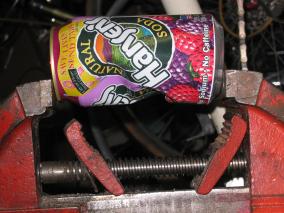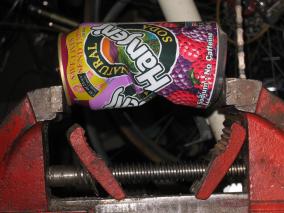See other failures under
000.html.
Cannondale frame buckle under braking
The owner reports fitting a disk brake, riding about 50km,
then fitting new brake pads and going for a ``hard braking'' test.
The owner weighs about 175kg and has broken many components in
normal riding, so he wore a full-face motorycycle helmet for the first
ride. In sustained hard braking down a hill,
he reports a ``crack'' sound, then it felt like the wheel jammed.
The bike flipped and the rider broke both arms. In looking at the
damage he suspects the frame buckled, allowing the front tire to
move back and jam on the frame.
Although the combination of rider weight, suspension fork, and disk
brake seems like it might be ``overload'', it is worth noting that
- This was not a fatigue failure.
- The frame was purchased new and was nearly new at the time of
collapse. No rider weight limit is listed.
- The rider bought the largest frame size, which is presumably also
used by heavy riders.
- Although most riders are below 175kg, the frame is a touring frame
and it is ordinary for riders to carry 30-40kg of gear.
140kg riders are more common.
- The suspension fork was likely compressed to the bottom
stop during braking -- the rider can compress it most of the way while
standing next to the bike simply by pressing down firmly on the
handlebars. Thus, the forks were not an unusally long lever.
- Although disk brakes provide strong and repeatable braking with
modest hand force, rim brakes can exert just as high peak forces.
With either kind of brake, hard braking causes either wheel
lockup or skid, depending on traction.
![[Buclked down tube]](img-0.125-img_1240.jpg)
![[Buclked down tube]](img-0.125-img_1242.jpg)
![[Buclked down tube]](img-0.125-img_1243.jpg)
![[Buclked down tube]](img-0.125-img_1246.jpg)
![[Buclked down tube]](img-0.125-img_1250.jpg)
Some suggestions/observations from other folks:
- The down tube damage may have been for some reason other than
braking load, including pre-accident damage and post-accident
damage.
- The paint in the dent was not obviously damaged by a hard object.
The paint is also not obviouslly damaged by the dent, so the
paint is both flexible and fairly strong.
- Hold a straight edge against the close-in side picture.
Note the non-buckled side of the frame has a distinct
curve, indicating the tube is bent.
It is unlikely the tube was manufactured that way.
- The front brake was serviced immediately before the accident.
Service might have caused the damage, but service makes it
more likely any pre-existing damage would have been noticed
during service.
- The pavement was relatively clean, it is not obvious what would have
been thrown up to cause such damage.
- The bike and rider wound up tangled together after the accident,
which might have caused frame damage afterwards.
It is not obvious
what part of the rider or clothing would have caused such a dent.
- The ``crack'' sound and lack of other evidence of broken or damaged
equipment suggests frame damage during braking.
It is possible the frame was struck by street debris to make the
noise, but note the street was fairly clean.
- The top tube was not closely examined for damage (a mistake).
The full side view picture shows the rear brake cable close
to the bottom edge of the tube at the ends, but in the center,
the wall behind is visible. That suggests the top tube is
slightly bent. However, that may be ``thinner in the middle,
thicker at the ends.'' A straight edge along the top of the
tube suggests slight bending, but less than suggested by the
cable.

- If the frame bent during braking, the combination of varying
decelleration and rearward motion of the tire contact patch
may have contributed to the rider being thrown.
- If the frame bent during braking, the tire might have contacted the
down tube but the tire might have been stopped when that
happened. Thus, there might be no skid mark on the down tube.
- The suspension may have bottomed. The impulse may have raised frame
tube forces. At the same time, the impulse may have increased
traction, thus increasing the braking force and further
increasing frame tube forces.
- The Cannondale frame is made of thin-walled large-diameter tubes,
different than typical bike frame tubing. Thus, the failure
mode may be unfamiliar.
An empty aluminum soda can was crushed using a vise applying an
off-axis load.
The can has an even larger diamter and even thinner wall.
Minor loading caused the can to emit a ``crack'' sound and buckle.
The non-loaded side of the can did not wrinkle or show other
damage evidence, even under further crushing. (This experiment
should be repeated with slight initial damage to the can.)
Note the frame tube is tapered so it has further variations along its length.



See also
FAIL-018.html.




![[Buclked down tube]](img-0.125-img_1240.jpg)
![[Buclked down tube]](img-0.125-img_1242.jpg)
![[Buclked down tube]](img-0.125-img_1243.jpg)
![[Buclked down tube]](img-0.125-img_1246.jpg)
![[Buclked down tube]](img-0.125-img_1250.jpg)



